The Appalachian shale gas play has attracted majors hunting for elephants and government entities seeking tax revenues and political gains.
Pramod Kulkarni, Contributing Editor
In 2009, the Marcellus Shale achieved critical mass—advancing from a frontier niche of US independents to the world’s leading onshore natural gas play. This transformation is the end product of US majors’ assessments of the lucrative potential of the Marcellus Basin matched to the need of some of the independents to firm up their financial resources in the face of falling natural gas prices. High initial production rates and rapid, high-priced leasing activity have also attracted the attention of local, state and federal authorities seeking tax revenues and the opportunity to make political gains as the guardians of the environment and drinking water.
BASIN POTENTIAL
The Marcellus Shale play, the largest unconventional gas reserve in the world, has estimated gas in place of nearly 500 Tcf and recoverable reserves of about 50 Tcf. The organic-rich shale play stretches from northern West Virginia through western Ohio and eastern Pennsylvania to New York at an average depth of one mile below the surface, Fig. 1.
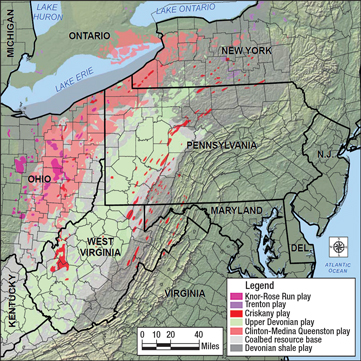 |
|
Fig. 1. The Marcellus Shale is the largest contiguous natural gas deposit in the world.
|
|
High recovery. Range Resources, which drilled the first commercial well in the Marcellus in 2004, estimates the estimated ultimate recovery (EUR) of its Marcellus wells at 4.4 Bcf equivalent compared to 7.8 Bcfe for the Haynesville and 2.2 Bcfe for the Barnett, Fig. 2. XTO reports EUR of 3 Bcfe for Marcellus, with the Barnett at 3.3 Bcfe; Fayetteville, 2.2; Woodford, 3.8; and Haynesville, 6.5. CNX Gas estimates EUR for its Marcellus wells at 3.5 Bcfe, and Seneca Energy, a subsidiary of National Fuel Gas Co., has indicated an EUR of 3.0 Bcfe. The Marcellus play becomes more attractive due to lower finding and development (F&D) costs when compared to the high-pressure, high-temperature wells needed in the Haynesville, and due to its proximity to the Northeastern gas markets.
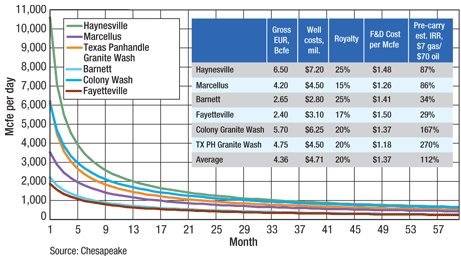 |
|
Fig. 2. Decline curves, EUR and cost comparisons for various shale plays.
|
|
Economic growth. The Marcellus play has the potential to uplift the economic landscape of the Appalachian region, which has been in a downturn for decades. Marcellus Shale development will pump $14.17 billion into Pennsylvania’s economy in 2010 and create more than 98,000 jobs, while generating $800 million in state and local tax revenues, according to an economic study by the Pennsylvania State University. Pennsylvania currently imports about 75% of its natural gas consumption. If Marcellus activity continues as expected, the state could reverse its position as a natural gas importer to become a net exporter by 2014.
LEASING ACTIVITY
The Marcellus prospective area is about 15 million acres. There was a “land rush” from 2004 to 2009 to acquire leases before the landowners were fully aware of the lucrative potential of the shale play. According to Chesapeake, the Big Four operators who participated in the land rush (Chesapeake, Range Resources, Seneca and Talisman) will have the advantage of F&D costs of less than $1.75/Mcfe, while latecomers may have to contend with F&D costs greater than $2.50 Mcfe, Fig. 3.
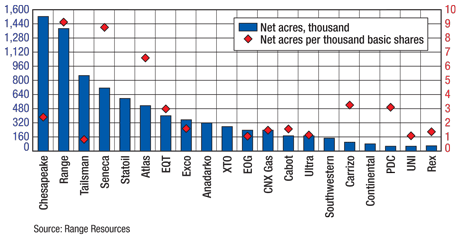 |
|
Fig. 3. Lease holdings in the Marcellus play.
|
|
Forest land leasing. Since 1947, Pennsylvania has leased 660,000 acres of forest land for oil and gas activity. In early 2010, Pennsylvania leased nearly 32,000 acres in the Marcellus, generating more than $128.5 million. Seneca Resources spent $80 million for two of the tracts, followed in spending by Exco, Penn Virginia, Chesapeake and Anadarko. Companies offered an average of $4,020 per acre, which is double the price of similar leases in 2008. Some landowners have reported prices above $5,000 per acre. Republicans in the state Senate are reportedly aiming to raise $180 million next year from additional gas leasing. The new state forest leases are more environmentally restrictive than previous leases. For example, drillers will be limited to building 123 well pads totaling no more than 645 acres, or about 2% of the total surface area. The operators must also pay royalties of 18% for gas sold from the wells, much higher than the state’s standard 12.5% royalty.
MERGERS AND ACQUISITIONS
Two multinational majors entered the Marcellus play in 2009: ExxonMobil and StatoilHydro (now Statoil). In addition, several of the small independent operators have signed joint ventures or sold assets elsewhere to spread the risk and increase funding for lease activity and E&P operations.
ExxonMobil and XTO. In December 2009, ExxonMobil announced a $41 billion transaction to acquire XTO Energy, giving it a foothold in the Marcellus play. Exxon-XTO was the largest upstream transaction since Chevron merged with Texaco in 2000 and accounted for almost two-thirds of the total value of transactions announced in 2009. ExxonMobil will establish a new upstream organization at XTO’s former Fort Worth headquarters to develop unconventional gas supplies throughout the world. The transaction is expected to be consummated in the second quarter of 2010. In the Marcellus play, XTO has drilled about 220 wells to discover net reserve potential of 500 Bcfe with an F&D cost of $1–$1.40/Mcfe.
Chesapeake and StatoilHydro. StatoilHydro paid $3.375 billion for a 32.5% interest in Chesapeake’s Marcellus Shale assets in the Appalachian Basin. The assets include about 1.8 million net acres of leasehold, of which Statoil will own about 0.6 million net acres and Chesapeake will own about 1.2 million net acres. Statoil paid $1.25 billion in cash at the closing with the remaining $2.125 billion committed to fund 75% of Chesapeake’s 62.5% share of drilling and completion expenditures through 2012. In addition to Marcellus participation, Statoil expects to employ Chesapeake’s shale expertise to jointly explore unconventional gas opportunities elsewhere in the world.
Chesapeake has also signed a letter of intent with Epsilon, a Canadian operator, for the development of its Highway 706 prospect. Chesapeake will earn a 50% stake by paying $5 million in cash up front and by carrying the first $95 million of Epsilon’s 50% share of the leasehold, drilling, completing, equipping and gathering costs associated with the prospect.
Anadarko and Mitsui E&P. Anadarko announced a joint venture with Mitsui E&P, which will become a 32.5% partner in Anadarko’s Marcellus Shale assets for about $1.4 billion. Mitsui will receive about 100,000 net acres in exchange for funding Anadarko’s entire share of development costs in 2010, and 90% of such costs from then until 2013. In addition, Mitsui will have the opportunity to purchase a 32.5% share of Anadarko’s existing wells and additional acreage acquisitions with a payment of about $100 million.
PDC and Lime Rock. Petroleum Development Corporation (PDC) and Lime Rock Partners have formed a joint venture, PDC Mountaineer, principally focused in the Marcellus shale region. PDC will contribute acreage, producing properties, reserves and related gathering assets valued at about $158.5 million. Lime Rock funded $45 million as a return of capital at closing, and PDC has an option to take a second cash contribution of $11.5 million by year-end 2010. PDC recently completed its first 3D seismic shoot and the drilling of seven initial vertical wells, and plans to drill its initial horizontal well in the first quarter of 2010.
Service company acquisitions. In strategic actions parallel to the entry of majors into the Marcellus play, Baker Hughes and Schlumberger have acquired service company rivals to improve their ability to serve as sole sources of a full range of shale E&P services. In March, Baker Hughes will complete the acquisition of BJ Services, a leader in shale fracturing services. In the latter half of 2010, Schlumberger will gain Smith International’s drillbit business as well as full control of the M-I Swaco drilling fluids business. Smith has set several performance records in the Marcellus, and M-I Swaco is well-established in the region. BJ Services provides pressure pumping and tubular services to many of the leading Marcellus operators.
E&P EXPENDITURES
Several operators in the Marcellus play plan to increase their E&P investment in 2010. These include Chesapeake Energy (+40%), EOG Resources (+21%), Hess (+55%), Noble Energy (+36%), Range Resources (+27%) and SandRidge Energy (+54%). Talisman expects to spend $1.6 billion in 2010 for its Marcellus development. Range Resources expects to spend 43% of its $740 million E&P budget in the Marcellus.
DRILLING OUTLOOK
In 2009, Pennsylvania and West Virginia drilled the second and third most wells in the US At year-end, 56,636 wells were drilled in Pennsylvania and 50,602 in West Virginia. Drilling is expected to continue to rise in the Marcellus due to a short drilling window of six months to two years for most leases. The state of Pennsylvania issued 1,984 Marcellus Shale drilling permits in 2009 with operators reporting 763 Marcellus wells drilled (compared to just 195 Marcellus wells drilled in 2008), Fig. 4. Among the operators, Chesapeake had 24 rigs operating in the Marcellus in January. Range Resources had 13 rigs working in the play at year-end 2009. The Pennsylvania Department of Environmental Protection (DEP) expects permit applications for 5,200 Marcellus wells in 2010. According to World Oil’s drilling forecast, West Virginia is expected to double its well count to 1,200 wells in 2010 and Pennsylvania is expected to see an increase to 4,570 wells.
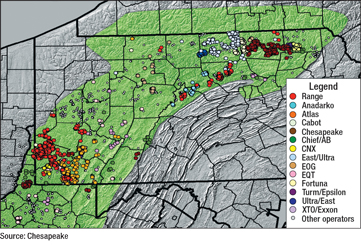 |
|
Fig. 4. New drilling permits issued in the Marcellus play during 2009.
|
|
PRODUCTION OUTLOOK
Regional demand in the Northeast averages about 13 Bcfd, with seasonal highs of more than 20 Bcfd and lows near 8 Bcfd. The region has a number of coal-fired electric power plants. If this capacity were converted to natural gas, the demand would increase by an additional 9 Bcfd.
Appalachia currently produces around 2.5 Bcfd of gas, of which 2.0 Bcfd is conventional and 0.5 Bcfd comes from the Marcellus. Tudor Pickering analysts project that the Appalachian gas production could reach as much as 6.0 Bcfd by 2013—with 4.5 Bcfd coming from the Marcellus Shale. Production could continue to increase to 9 Bcfd by 2020, Fig. 5.
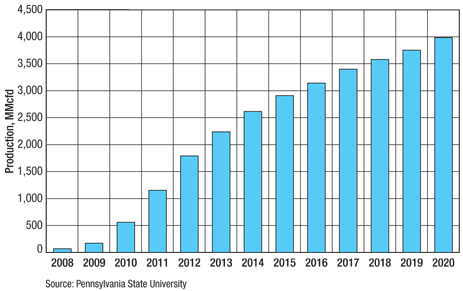 |
|
Fig. 5. Projected Marcellus gas production, 2008–2020.
|
|
Range Resources has current net production of more than 100 MMcfed. Its best horizontal well to date had initial production (IP) of 26.0 Mmcfed and averaged 10.8 MMcfed for 30 days. Biju Perincheril, an analyst with Jefferies, expects Range’s production to double by the end of 2010. Chesapeake is currently producing 50 MMcfed and plans to double production by year-end. Seneca Energy plans to produce 30–50 MMcfd by September 2010 and 60–100 MMcfd by September 2011.
TRANSPORTATION OUTLOOK
One of the economic advantages of the Marcellus play is its proximity to the Northeastern gas market and easy access to the pipelines that serve the region. The Tudor Pickering report forecasts that the energy industry will spend more than $10 billion to expand transportation and processing infrastructure in the Appalachian region between 2009 and 2013. Plans for more than 6 Bcfd of new pipeline capacity, 250 MMcfd of processing capacity and 40 MMcfd of fractionation capacity have been announced since the Marcellus play started to heat up. Pipeline companies with existing infrastructure have played a critical role in the expansion, Fig. 6.
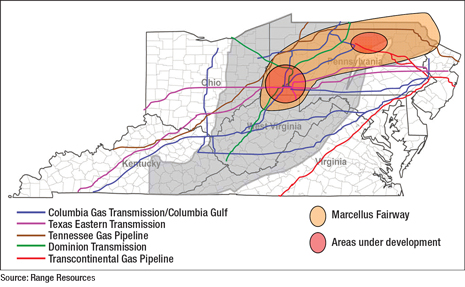 |
|
Fig. 6. Pipeline infrastructure in the Marcellus fairway and areas under pipeline development. Photo courtesy of Range Resources.
|
|
NiSource’s 100-MMcfd Columbia Penn pipeline and Williams Companies’ 100-MMcfd Sentinel expansion both entered service late last year, and Spectra Energy’s 395-MMcfd Temax and 60-MMcfd Time III expansions are both expected to come online in the second half of 2010. El Paso has executed 20-year agreements with Chesapeake and Statoil for 100% capacity on its Northeast Upgrade project, which will provide 636 MMcfd of incremental capacity in its interconnect pipeline from Pennsylvania to New Jersey. In a similar transaction, Williams and Cabot Oil & Gas have signed a long-term agreement to fund the construction of 28-mi natural gas gathering pipeline that will deliver Cabot’s Marcellus production to the Transco interstate gas pipeline.
Other major pipeline projects in the works include National Fuel Gas Co.’s West-to-East/Appalachian Lateral expansion, Dominion Resources’ Appalachian Gateway expansion and NiSource’s New Penn pipeline. Spectra Energy plans for an 800-MMcfd expansion to move Marcellus gas into New York and New Jersey. Millennium is gauging interest in linking Marcellus production to Manhattan for service beginning in November 2013.
GAS PROCESSING
The “wet” gas in southwestern Pennsylvania requires processing infrastructure to extract heavier gases such as propane, ethane and butane. Range Resources has formed a joint venture with MarkWest to establish cryogenic facilities to handle 155 MMcfd of wet gas and 25 MMcfd of dry gas that does not require processing. By mid-2011, additional infrastructure projects are expected to increase the processing capacity to more than 300 MMcfd.
WATER MANAGEMENT
Marcellus wells typically require about 2,000 bbl of water for drilling and about 90,000 bbl for fracturing, according to experts at ALL Consulting. The principal sources of water are the Delaware, Susquehanna, Ohio and Monogahela rivers. In addition, it is possible to make use of private stock ponds or wastewater from municipal and industrial facilities.
Options for managing flowback water after fracturing and produced water include recycling, water treatment either onsite or at a commercial water treatment facility, or injection into a formation below the aquifer. According to the Marcellus Shale Coalition, operators are recycling 60% of their flowback water. More than a dozen commercial treatment facilities are available, and the Pennsylvania DEP is reviewing applications for about 12 additional treatment facilities associated with shale gas drilling. Operators typically use trucks or rail tanks to transport the water to the treatment plants or disposal wells. For wastewater injection, there are six disposal wells in New York and eight in Pennsylvania.
Chesapeake has developed a flowback water recycling plant in Braxton County, West Virginia, that the company claims conserves freshwater and achieves cost savings of more than $6 million a year. The automated two-pump system is capable of processing 2,100 bbl of saltwater a day, Fig. 7.
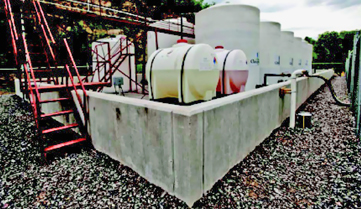 |
|
Fig. 7. Chesapeake’s recycling plant in Braxton County, West Virginia, can treat 2,100 bbl of saltwater per day.
|
|
INFRASTRUCTURE EXPANSION
The gas industry’s long-term interest in the Marcellus play is the expansion of repair and maintenance, warehousing and administrative office facilities in the region. Most operators have established regional headquarters in Pennsylvania. The service companies are also expanding their regional capabilities. In the northern Marcellus, Schlumberger has upgraded a base in Bradford, Pennsylvania, and is in the process of building a 60-acre oilfield services facility in Horseheads, New York. In the southern Marcellus, Schlumberger has replaced its 50-year-old Glennville facility with a larger facility in Weston, West Virginia. Meanwhile, Baker Hughes is building a regional service facility in New Stanton, Pennsylvania.
REGULATORY ISSUES
The Obama administration is examining shale gas operations with the intention of regulating hydraulic fracturing under the Safe Drinking Water Act. Lisa Jackson, head of the Environmental Protection Agency, wants a review of the “risk that fracturing poses to drinking water in light of various cases across the country that raise questions” about the process. In its 2011 budget, the EPA seeks to secure $4 million to study the environmental impact of hydrofracturing.
In the US Congress, legislative proposals are underway to force shale gas operators to disclose the chemical composition of their fracturing solutions. Sen. Bob Casey (D–Pa.) has introduced legislation titled the Fracturing Responsibility and Awareness of Chemicals (FRAC) Act. If enacted, the law would require “any person using hydraulic fracturing disclose the chemical constituents (but not the proprietary chemical formulas) used in the fracturing process.”
US Reps. Diana DeGette (D–Colo.) and Maurice Hinchey (D–N.Y.) have introduced companion legislation that would repeal the oil and gas industry’s exemption from disclosure obligations under the Safe Drinking Water Act. DeGette wants the regulatory authority over fracturing to go to the EPA under the Safe Drinking Water Act, whereas the operators would prefer the regulatory authority to remain with the states. The conflicting positions were on display during congressional hearings regarding the XTO merger on Jan. 9 with testimony from Rex Tillerson, chairman and CEO of ExxonMobil. The industry is concerned that the EPA would take regulatory steps that would either ban the practice altogether or make it too expensive to drill. An escape clause in the acquisition agreement with XTO allows ExxonMobil to walk away from the deal if Congress makes hydraulic fracturing illegal or commercially impractical.
On Feb. 18, the House Energy and Commerce Committee announced an investigation into the potential impacts of hydrofracturing on human health and the environment. Committee Chairman Henry Waxman (D–Calif.) and Energy Subcommittee Chairman Edward Markey (D–Mass.) have asked eight hydrofracturing companies, including Halliburton, Baker Hughes and BJ Services, to provide information on their processes.
New York state regulations. In September 2009, the New York State Department of Environmental Conservation issued a draft environmental impact statement on horizontal drilling and high-volume hydraulic fracturing in the state. The draft statement is required for the state to review and process permit applications for the horizontal drilling and hydraulic fracturing of natural gas- bearing shales. The EPA is on the record stating that the draft report needs to be significantly expanded to cover potential impacts in the future as well as regions away from the immediate drilling site involving water supply, water quality and wastewater treatment. New York City’s Mayor Michael Bloomberg wants the legislature to prohibit shale gas development in the city’s watershed area. To stave off further controversy, Chesapeake announced in October 2009 that it has no intention of drilling natural gas wells within the watershed.
Pennsylvania severance tax. At present, the industry must pay severance tax in West Virginia (5% on wellhead value) and Ohio ($0.025/Mcf). West Virginia has imposed an additional $0.047/Mcf tax on the Marcellus prospects. In both houses of the Pennsylvania legislature, proposals are in place to match severance taxes equivalent to those of West Virginia. Pennsylvania Gov. Ed Rendell had tabled several tax ideas when natural gas prices were falling, but is now amenable to signing onto the legislation. The only differences in the various proposals address where the tax monies would be spent. A Pennsylvania State University study finds that the severance tax cannot be passed on to consumers and, therefore, drilling activity would decline by more than 30% and result in an estimated $880 million net loss in the present value of tax revenue between now and 2020. Severance tax revenue gains are more than offset by declining state and local income taxes resulting from lower drilling activity under the severance tax. According to the study, the high level of drilling activity in Pennsylvania is a function of relatively lower taxes.
Industry countermoves. In June 2009, the API released a study suggesting that US oil and gas production would drop 20.5% over five years if federal frac regulation became law. As part of an opinion-shaping strategy, US Rep. Tim Murphy (R–Pa.) is co-chairing a newly formed Natural Gas Caucus to promote natural gas development. In Pennsylvania, many operators have joined to form the Marcellus Shale Coalition. The coalition shares its concerns about prospective regulatory and tax issues with regulators, government officials and the general public. In recent months, the coalition has spoken out against Pennsylvania’s proposed severance tax and released positive information about the industry’s flowback water treatment.
TECHNOLOGY ADVANCES
As in most shale plays, horizontal drilling and hydraulic fracturing have been the key technology enablers for the Marcellus play, Fig. 8. Several other technologies are bringing down F&D costs in the region.
Technology transfer. The Marcellus play development began after the industry developed shale gas expertise in other areas such as the Barnett Shale. Chesapeake reports that it took the company more than 10 years to perfect its shale completion process for the Barnett Shale. The company says it has applied its evolved process from the outset in the Marcellus play, greatly reducing the learning curve and expediting operations.
Rig designs. To reduce well construction costs and improve efficiency, many Marcellus operators are using padsites for drilling two to four wells from one location. Chesapeake is using Apex series rigs to drill these wells. The rigs are capable of “walking” up to 15 ft in two hours in any direction and/or turning 360° with 12,000 ft of pipe in the derrick. As such, operators can achieve faster mobilization and demobilization, reduce the amount of land and material needed for wellsite construction and decrease surface traffic in the area.
Global Energy Services has developed its QuickSilver drilling system specifically for the Marcellus, where operators face restricted load size and weight. The rig can be rigged down, transported up to 100 mi, and rigged up at a new location within 48 hours. Elevated components can be raised with integrated hydraulic cylinders without a crane.
Formation evaluation. During pilot well drilling, the Schlumberger ECS elemental capture spectroscopy sonde, in combination with the Platform Express integrated wireline logging tool, allow the operator to benchmark potential productivity. In the lateral section, the EcoScope multifunction LWD service provides integrated formation evaluation, well placement and drilling optimization measurements. This analysis provides information about core verified permeability, effective porosity, gas in place, total organic carbon, kerogen content and mineralogy. Some operators also complement this evaluation with the Sonic Scanner acoustic scanning platform or the SonicVision sonic-while-drilling tool to identify formation anisotropy, fracturing and mechanical properties. This information provides inputs for well trajectory, landing point and well fracture design.
Microseismic monitoring. The key to high production in the Marcellus play is hydraulic fracturing to exploit the natural fractures that exist in the shale formations. Several operators are using microseismic technology, developed extensively in the Barnett Shale, to develop fracturing orientation strategies, and are then monitoring how well the fractures open up once the stimulation is underway.
Initial experiments with areal acoustic arrays with operators such as Range Resources are leading to the application of buried array programs, such as the one announced in February by Marathon Oil with MicroSeismic Inc. A buried array will cover 20 sq mi and provide mapping services for the life of the field for multiple wells in the area. According to MicroSeismic, this will eliminate the need to drill expensive monitoring wells. CNX Gas has also shot microseismic surveys in its Marcellus fields and has used the resulting data to drill 500-ft laterals.
Rotary steerable drilling. Most Marcellus wells have been drilled using oriented mud motors. Considerable time is lost, however, because about 45% of the drilling time is spent in the sliding mode. CNX and Schlumberger have demonstrated the value of rotating the entire drillstring using a rotary steerable drilling system to increase lateral ROP by as much as 57%, while simultaneously reducing drillstring torque and wellbore tortuosity. The improved wellbore quality eases running casing to total depth.
Another drilling innovation is a double-pitchfork drilling pattern that CNX is applying for its horizontal laterals.
Zipper-fracing. Another technological innovation that promises to make shale well completions more efficient is zipper-fracing. CNX and Schlumberger have used this technique to complete two nearby wells simultaneously. After perforating the first stage on one well, the perforating team moves to the second well and perforates it, just as the frac team is pumping the first stage frac on the first well. After treatment, the first well is left pressured up and the frac team moves to the second well. For CNX, the zipper- frac procedure completed both wells in 30 hours, compared to the 24-hour time frame needed to complete a single well.
Cementless perforating. Weatherford has developed a completion technology called ZoneSelect that it claims eliminates perforating for cementless completions in Marcellus shale wells. The fracture goes out through pre-selected holes in the casing, which have sliding sleeves that are activated. The zones are isolated by a series of packers, which can be mechanical, inflatable or swellable.
Collidable chemistry for water treatment. Weatherford also offers CoMag fluids technology that speeds up the settling of particles out of water. The company says this process reduces the need for big settling ponds so higher volumes of water can be treated and recycled.
CRITICAL MASS TO CRITICAL SUCCESS
While the Marcellus Shale play has achieved critical mass, when could one say that it has achieved critical success? In today’s sports-dominated world, one sign of success is the ownership of a professional team. In late January, a news story out of Dallas reported that Rangers Baseball Express, an investment group that is poised to become the new owner of the Texas Rangers baseball team, includes investors Bob Simpson, the chairman of XTO Energy, and Ray C. Davis, retired chairman of Energy Transfers, who have made their fortunes from the Barnett Shale. Applying this economic indicator, one could say that the Marcellus Shale will have achieved critical success when some of the executives of the operating companies become the new owners of professional teams in Pennsylvania and New York. 
|
THE AUTHORS
|
 |
Pramod Kulkarni is a Houston-based technology writer and editor. With a BS degree in electrical engineering from Utah State University, an MA degree in journalism from the University of Iowa and an MBA from the University of Houston, he has over 25 years of experience in writing focused on oil and gas exploration, drilling, completion and production.
|
|










